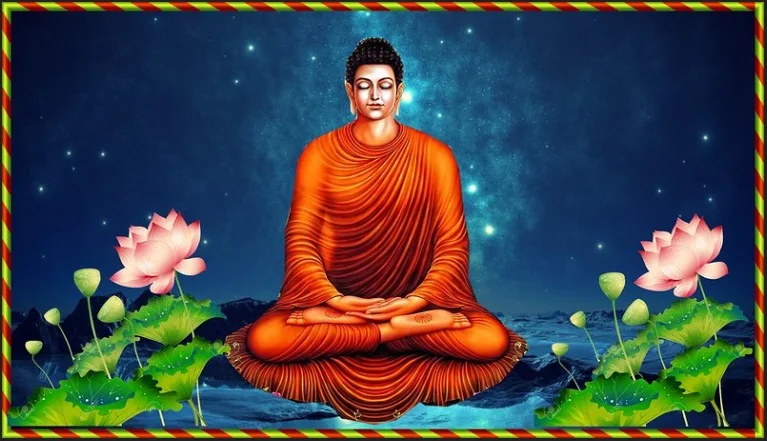The Scientific Philosophy of Buddhism Explained in Simple Terms
Buddha life Story in English | Philosophy of Buddhism
 |
| Buddha Life Story |
How Buddha Got Enlightened? | The True Story of How Buddha Became a Buddhist Monk
Lord Buddha
was born between the sixth and fourth century B.C., the son of a wealthy king
in the Himalayan foothills of Nepal. It was prophesied that the young Buddha then
called Siddhartha Gautama would either become the emperor of India or a very
holy man.
Since
Siddhartha's father desperately wanted to Siddhartha be the king, he kept the
child alone in the palace. Young Gautama had every imaginable luxury jewels, servants,
lotus ponds, even beautiful dancing women. Approximately For 29 years, Gautama
lived a comfortable life, but after some time stubbornness to travel outside
the palace.
So, what he
saw amazed him. First, he met a sick man, then an aging man, and then a dying
man. Show these kinds of people add them to the same image one by one. He was
shocked to learn that these misfortunes represent simple, inevitable parts of
the human condition that will one day even touch them.
Terrified
and fascinated, Gautama made the fourth trip outside the palace walls and met a
holy man, who had learned to seek spiritual life amidst the magnitude of human
suffering. Inspired by the holy man, Gautama left the palace for good. He tried
to learn from other holy men. He almost starved himself to death by avoiding
all material comforts. it did not bring solace to him from suffering. Then he
thought of a moment when he was a small boy; sitting by the river, he had
noticed that when the grass was cut, the insects and their eggs were trampled
and destroyed.
As a child,
he had felt deep compassion for tiny insects. Reflecting on his childhood
compassion, Gautama felt a deep sense of peace. He ate, meditated, and finally
reached a state of enlightenment called 'Nirvana'. It refers to the
"burning" of the flames of desire. With this, Gautama had become the
"Buddha". "Buddha means the awakened one".
What Buddha said after enlightenment | What did Buddha do after enlightenment
The Buddha
awoke by recognizing that all of creation, from distraught ants to dying human
beings, is unified by suffering. Seeing this, the Buddha found the best way to
deal with suffering. First, one should not bathe in luxury, nor should one
avoid food and comfort altogether. Instead, one ought to live in moderation.
The Buddha called this the middle way Which allows for maximal concentration on
cultivating compassion for others and seeking enlightenment Next, the Buddha
described a path to transcending suffering called The four noble truths.
Buddha's Four Noble Truths:
- The first good fact that the awareness that first inspired the Buddha's journey is that suffering and dissatisfaction are going on in the world.
- Second, the suffering we experience is due to our desires. As the Buddha said, "attachment is the root of all suffering."
- The third truth is that we can transcend suffering by removing or managing these desires.
- The fourth and final beautiful truth revealed by the Buddha is that we can learn beyond suffering from what he calls the eightfold noble path.
Buddha's Important Philosophy | Buddha life lessons
- The Buddha thus made the remarkable claim that we must change our outlook, not our circumstances.
- We are unhappy not because we do not have enough money, love, or position but because we are greedy, vain, and insecure.
- By refreshing our minds, we can grow to satisfaction.
- The people become happier superimpose smiles or use a second image of their face with the correct behavior and what we now term a mindful attitude; we can also become better people.
- We can turn negative emotions and attitudes; turn ignorance into wisdom, anger into compassion, and greed into generosity.
Buddhism after Buddha's Death | Why is Buddhism considered a peaceful religion?
After Lord
Buddha's death, his followers collected his "sutras" (sermons or
sayings) into scripture, and developed texts to guide followers in meditation,
ethics, and mindful living. Monks built during the Buddha's lifetime flourished
and multiplied, throughout China and East Asia.
For a time,
Buddhism was relatively uncommon in India itself, with only a handful of silent
monks and nuns roaming the countryside, quietly meditating. However, in the 3rd
century B.C., the king of India, Ashoka, became embittered by the wars he had
fought and converted to Buddhism. He sent monks and nuns far and wide to spread
the practice. Buddhist spiritual tradition spread across Asia and eventually
throughout the world.
Buddha's
followers are divided into two main schools, first is Theravada Buddhism
and the second is Mahayana Buddhism. Theravada Buddhism colonized
Southeast Asia and Mahayana Buddhism which took hold in China and Northeast
Asia. Today, between one and a half and a half billion Buddhists in the East
and West follow the teachings of the Buddha and seek enlightenment and
compassion.
Intriguingly,
the Buddha's teachings are important regardless of our spiritual
identification. Like the Buddha, we are all born on earth without realizing it,
and we cannot fully comprehend how misfortune, sickness, and death will befall
us. As we grow older, these truths are often more powerful, and we may want to
avoid them altogether.
The
teachings of the Buddha remind us of the importance of dealing directly with suffering. We should do all we can to free ourselves from the clutches of our
desires, and realize that suffering can be viewed as part of our common
communication with others, spurring us to compassion and gentleness. Hopefully,
you may like the scientific story of Lord Buddha, If you like then must share
it with your friends and family. And of course never forget to subscribe to
milliondollarknowledge.com.
Download Buddha's
Life Story Click Here
More You
Like to Read:
Thank You!
Million-$-Knowledge





